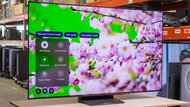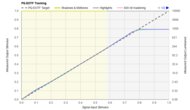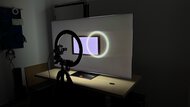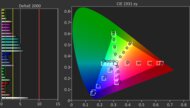These days, you can find very good TVs for under $1,500. New technologies are finding their way into the more mainstream models, making them available to a wider range of people, as you can now get a solid option for cheaper than you used to. By putting dozens of TVs a year through our standardized testing process, we've confirmed that you can easily find some high-end TVs with outstanding picture quality and a ton of features for under $1,500 if you're willing to cut on size a bit, as you may be limited to a 55- or 65-inch screen. If you'd rather have an even bigger size, there are still affordable models with good picture quality available in 75-inch and bigger models.
Below are our recommendations for the best TVs under $1,500 you can buy. For other options, check out our recommendations for the best TVs under $1,000, the best TVs under $2,000, and the best budget TVs, or vote on which ones you want us to buy and test. To learn more about the 2025 models, check out our 2025 TV lineup page.
Quick Look






We buy and test dozens of TVs yearly, taking an objective, data-driven approach to deliver results you can trust. Our testing process is complex, with hundreds of individual tests that take over a week to complete. Most of our tests are done with specially designed test patterns that mimic real content, but we also use the same sources you have at home to ensure our results match the real-world experience. We use two main tools for our testing: a Colorimetry Research CR-100 colorimeter and a CR-250 spectroradiometer.
-
Best TV Under $1,500
 Mixed Usage8.6Home Theater8.8Bright Room7.6Sports8.1Gaming9.1Game Mode Responsiveness9.4Brightness8.0Black Level10Color8.8Processing (In Development)8.4Resolution4kNative Refresh Rate144HzScreen FinishGlossyTypeOLEDSub-TypeQD-OLEDSee all our test resultsDolby VisionNo
Mixed Usage8.6Home Theater8.8Bright Room7.6Sports8.1Gaming9.1Game Mode Responsiveness9.4Brightness8.0Black Level10Color8.8Processing (In Development)8.4Resolution4kNative Refresh Rate144HzScreen FinishGlossyTypeOLEDSub-TypeQD-OLEDSee all our test resultsDolby VisionNoThe best TV under $1,500 we've tested is the Samsung S90F OLED. It's a fantastic option for pretty much any usage. Thanks to its perfect black levels, it looks amazing in a dark room, delivering inky blacks with no distracting haloing around bright highlights or subtitles. It's also a decent choice for a good choice for most well-lit rooms, as it gets bright enough to overcome glare and has solid reflection handling. However, if you're in a very bright room with a lot of natural sunlight, you might want to consider our other Samsung option below. Still, HDR content looks amazing thanks to its top-tier color performance, delivering bright, vibrant colors that look very realistic. You can find its 55-inch model for under $1,500, and its 65-inch model sits just around that during sales.
It's a versatile TV with a great selection of additional features. It has four HDMI 2.1 ports capable of 4k @ 144Hz with VRR, so you can take full advantage of the latest consoles or high-end gaming PCs. The TV has nearly instantaneous pixel transitions, so motion is crisp and clear. Finding content to watch is easy thanks to the huge selection of streaming apps, and its wide viewing angle means you can watch content with friends seated to the sides of the screen, and they won't have to look at degraded image quality. You'll want to stick with the 55, 65, and 77-inch models to ensure you get a QD-OLED panel, and even then, this varies depending on your region.
-
Best Bright Room TV Under $1,500
 Mixed Usage8.2Home Theater8.1Bright Room8.7Sports8.5Gaming7.8Game Mode Responsiveness7.8Brightness9.0Black Level8.3Color7.7Processing (In Development)7.7Resolution4kNative Refresh Rate165HzScreen FinishMatteTypeLEDSub-TypeVASee all our test resultsDolby VisionNo
Mixed Usage8.2Home Theater8.1Bright Room8.7Sports8.5Gaming7.8Game Mode Responsiveness7.8Brightness9.0Black Level8.3Color7.7Processing (In Development)7.7Resolution4kNative Refresh Rate165HzScreen FinishMatteTypeLEDSub-TypeVASee all our test resultsDolby VisionNoIf you're looking for the very best TV under $1,500 for a very bright room, the Samsung QN90F is an excellent choice. Unlike most TVs on the market, it has a matte screen coating that almost eliminates reflections entirely. Combined with its fantastic SDR brightness, visibility isn't an issue in even the brightest environments. Although it doesn't display the same perfect blacks as the Samsung S90F, it still has effective local dimming that helps make blacks look deep, with only some haloing around highlights and subtitles. Colors are vibrant and bright on this model, and highlights stand out well in HDR, so you get an impactful HDR viewing experience, especially in darker rooms. Unfortunately, its viewing angle isn't nearly as wide as it is on the S90F, so even though it's fine if you're sitting at a slight angle from the screen, image quality degrades rapidly from more aggressive angles.
If you're a gamer, the TV has a ton of modern gaming features, like four HDMI 2.1 ports, 4k @ 165Hz, and VRR, so it's great for console and PC gamers. However, pixel transitions are a bit slow on this model, so there's some noticeable motion blur in faster games. Unfortunately, you're limited to the 55-inch model with a budget of $1,500, but you might find the 65-inch model on sale for around that cost. If you're solely looking for a TV for a bright room, this model is a great option, but consider our next pick if you want something that's better all around.
-
Best Mid-Range TV Under $1,500
 Mixed Usage8.4Home Theater8.6Bright Room8.4Sports8.3Gaming8.4Game Mode Responsiveness8.0Brightness9.1Black Level9.2Color8.0Processing (In Development)7.8Resolution4kNative Refresh Rate144HzScreen FinishGlossyTypeLEDSub-TypeVASee all our test resultsDolby VisionYes
Mixed Usage8.4Home Theater8.6Bright Room8.4Sports8.3Gaming8.4Game Mode Responsiveness8.0Brightness9.1Black Level9.2Color8.0Processing (In Development)7.8Resolution4kNative Refresh Rate144HzScreen FinishGlossyTypeLEDSub-TypeVASee all our test resultsDolby VisionYesThe TCL QM8K is one of the best all-around Mini LED models on the market. It doesn't display the same perfect blacks as OLEDs, but it's surprisingly close, since its local dimming makes blacks incredibly deep and bold, with almost no haloing around subtitles and highlights. This is one of the brightest options on the market, and it has solid reflection handling, so it overcomes glare in most bright rooms, as long as you don't have any light sources directly shining onto the screen. It also displays a wide range of bright and punchy colors, making it a versatile TV that looks great in any room. Highlights really pop out in HDR content, so you get an impactful HDR experience in home theater settings.
Unlike the Samsung models, it only has two HDMI 2.1 ports, which might be limiting for those with several gaming consoles. However, those two ports support 4k @ 144Hz and 1080p @ 288Hz with VRR, so it takes full advantage of modern consoles and is a versatile choice for PC gamers. Pixel transitions are pretty fast for a Mini LED model, so motion blur is kept to a minimum in most games. Its viewing angle is good enough if you're watching from a slight angle, but image quality does degrade from more aggressive angles. You can typically only find the 65-inch model for under $1,500, but you might be able to find the 75-inch for around that cost during sales. If you're looking for the best 75-inch TV under $1,500 and can't find the QM8K on sale, consider our next pick, the TCL QM7K.
-
Best Lower Mid-Range TV Under $1,500
 Mixed Usage7.8Home Theater7.9Bright Room8.0Sports7.9Gaming7.8Game Mode Responsiveness8.0Brightness7.8Black Level8.4Color7.5Processing (In Development)7.7Resolution4kNative Refresh Rate144HzScreen FinishGlossyTypeLEDSub-TypeVASee all our test resultsDolby VisionYes
Mixed Usage7.8Home Theater7.9Bright Room8.0Sports7.9Gaming7.8Game Mode Responsiveness8.0Brightness7.8Black Level8.4Color7.5Processing (In Development)7.7Resolution4kNative Refresh Rate144HzScreen FinishGlossyTypeLEDSub-TypeVASee all our test resultsDolby VisionYesThe lower mid-range TCL QM7K is the best 75-inch TV under $1,500 we've tested. Although it's less advanced than the more expensive options on this list, it still delivers great overall picture quality. Blacks aren't quite as deep as they are on the TCL QM8K, but they're still bold due to the TV's great local dimming solution. The TCL also has excellent peak brightness and decent enough reflection handling to overcome glare, so it's no slouch in a bright room, as long as you avoid placing any light sources directly opposite the screen. Colors are vibrant enough to please most people, and even though it's not as bright as the QM8K in HDR, the TV still displays HDR content with impact.
Like the QM8K, it has a narrow viewing angle, so it's best viewed from directly in front. Fortunately, the TV has the same selection of gaming features as the QM8K, including two HDMI 2.1 ports, 4k @ 144Hz, 1080p @ 288Hz, and VRR support to reduce screen tearing. It even has similarly quick pixel transitions, so motion has minimal blur behind it. This is a very solid option if you want a large TV with good image quality, versatility, and a ton of features.
-
Best Budget TV Under $1,500
 Mixed Usage7.1Home Theater7.2Bright Room7.0Sports7.1Gaming7.2Game Mode Responsiveness7.9Brightness6.5Black Level7.6Color7.2Processing (In Development)7.0Resolution4kNative Refresh Rate144HzScreen FinishGlossyTypeLEDSub-TypeVASee all our test resultsDolby VisionYes
Mixed Usage7.1Home Theater7.2Bright Room7.0Sports7.1Gaming7.2Game Mode Responsiveness7.9Brightness6.5Black Level7.6Color7.2Processing (In Development)7.0Resolution4kNative Refresh Rate144HzScreen FinishGlossyTypeLEDSub-TypeVASee all our test resultsDolby VisionYesIf you're willing to give up some image quality for a huge screen, the best 85-inch TV under $1,500 is the TCL QM6K. It's not as bright as the TCL QM7K, but its SDR peak brightness is still good, so it overcomes glare from most indirect light sources. On the other hand, it's not very bright in HDR, so some highlights in HDR content don't pop the way they would on the higher-end options on our list. Fortunately, it delivers deep blacks thanks to its great local dimming feature, although there's some noticeable haloing. Still, it's an impressive TV for the cost, displaying a wide range of vibrant colors that prevent the image from looking muted and lifeless.
It includes the same core gaming features as its more expensive sibling, including two HDMI 2.1 ports, support for 4K @ 144Hz, 1080p @ 288Hz, and VRR, so even though you don't get the same level of image quality, you get the same features. It has the same narrow viewing angle as the other TCL models, so it looks best when viewed from the front. Similar models from different brands like Sony, LG, and Samsung are typically more expensive, have worse image quality, and are a lot lighter on features, so this TV truly stands out in the budget category.
Notable Mentions
-
LG C5 OLED:
The LG C5 OLED is a good alternative to the Samsung S90F OLED. It performs better in bright rooms, but the Samsung offers higher brightness in its gaming mode and delivers more vivid colors with less banding, making it the stronger choice overall.
See our review -
LG B5 OLED:
If you prefer the exceptional motion clarity and wide viewing angle of an OLED over a Mini LED model like the TCL QM8K, the LG B5 OLED offers those benefits at a similar price. However, the TCL outshines it with its significantly brighter panel, comparable black levels, and more well-rounded feature set, making it the better choice for most people.
See our review -
Hisense U75QG:
The Hisense U75QG is comparable to the TCL QM7K but delivers higher peak brightness. However, it makes HDR content appear brighter than intended and shows more noticeable motion blur because of slower pixel transitions. With clearer motion, better black levels, and support for 1080p @ 288Hz, the TCL stands out as the better overall TV.
See our review -
Hisense U65QF:
The Hisense U65QF is a brighter alternative to the TCL QM6K. Unfortunately, the Hisense really overbrightens HDR content, so it doesn't stay true to the content creator's intent. The TCL offers the more complete package, with better black levels, superior accuracy, 1080p @ 288Hz, and lower input lag.
See our review
Recent Updates
Nov 13, 2025:
We reviewed the article and confirmed the accuracy of our picks.
Aug 15, 2025:
Replaced the Samsung S90D with the Samsung S90F as our new top pick, the Samsung QN90D with the Samsung QN90F in our 'Best Bright Room' category, the LG B4 OLED with the TCL QM8K in our 'Best Mid-Range' category, the TCL QM751G with the TCL QM7K in the 'Lower Mid-Range' category, and the Hisense U6N with the TCL QM6K in the 'Budget' category. We also refreshed the Notable Mentions section to bring it up to date, and dropped the 'Best Upper Mid-Range' category since it's redundant.
Apr 23, 2025:
Confirmed the validity of our picks and updated some text throughout the article for accuracy.
Dec 17, 2024:
We added the Hisense U6/U6N to the newly-created 'Best Budget TV Under $1,500' category and refreshed the introduction text to bring it up-to-date.
Sep 27, 2024: Replaced the Sony X93L/X93CL with the Hisense U8/U8N in the 'Best Bright Room 4k TV Under $1,500' category and the Hisense U7N with the TCL QM7/QM751G QLED in the 'Best Lower Mid-Range TV Under $1,500' category. We also replaced the Samsung S90C OLED, LG C3 OLED, and LG B3 OLED with their 2024 successors and updated the Notable Mentions.
All Reviews
Our recommendations above are what we think are currently the best TVs under $1,500 to buy for most people. We factor in the price (a cheaper TV wins over a pricier one if the difference isn't worth it), feedback from our visitors, and availability (no TVs that are difficult to find or almost out of stock everywhere).
If you'd like to do the work of choosing yourself, here's the list of all our TV reviews. Be careful not to get too caught up in the details. While no TV is perfect, most TVs are great enough to please almost everyone, and the differences are often not noticeable unless you really look for them. Also, keep in mind that our scores aren't comparable across different test benches, so most of the TVs in the list below score higher than they would today.















